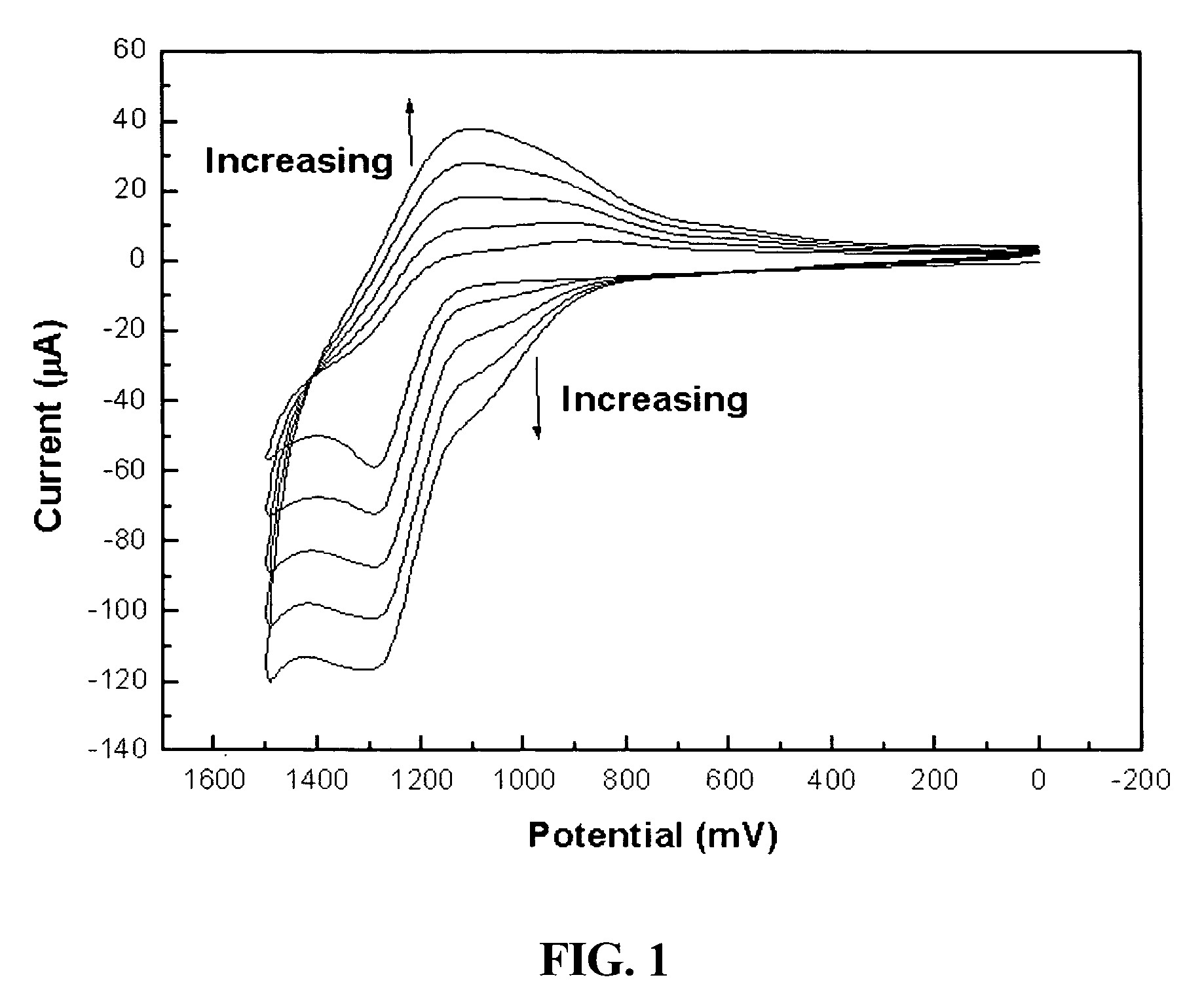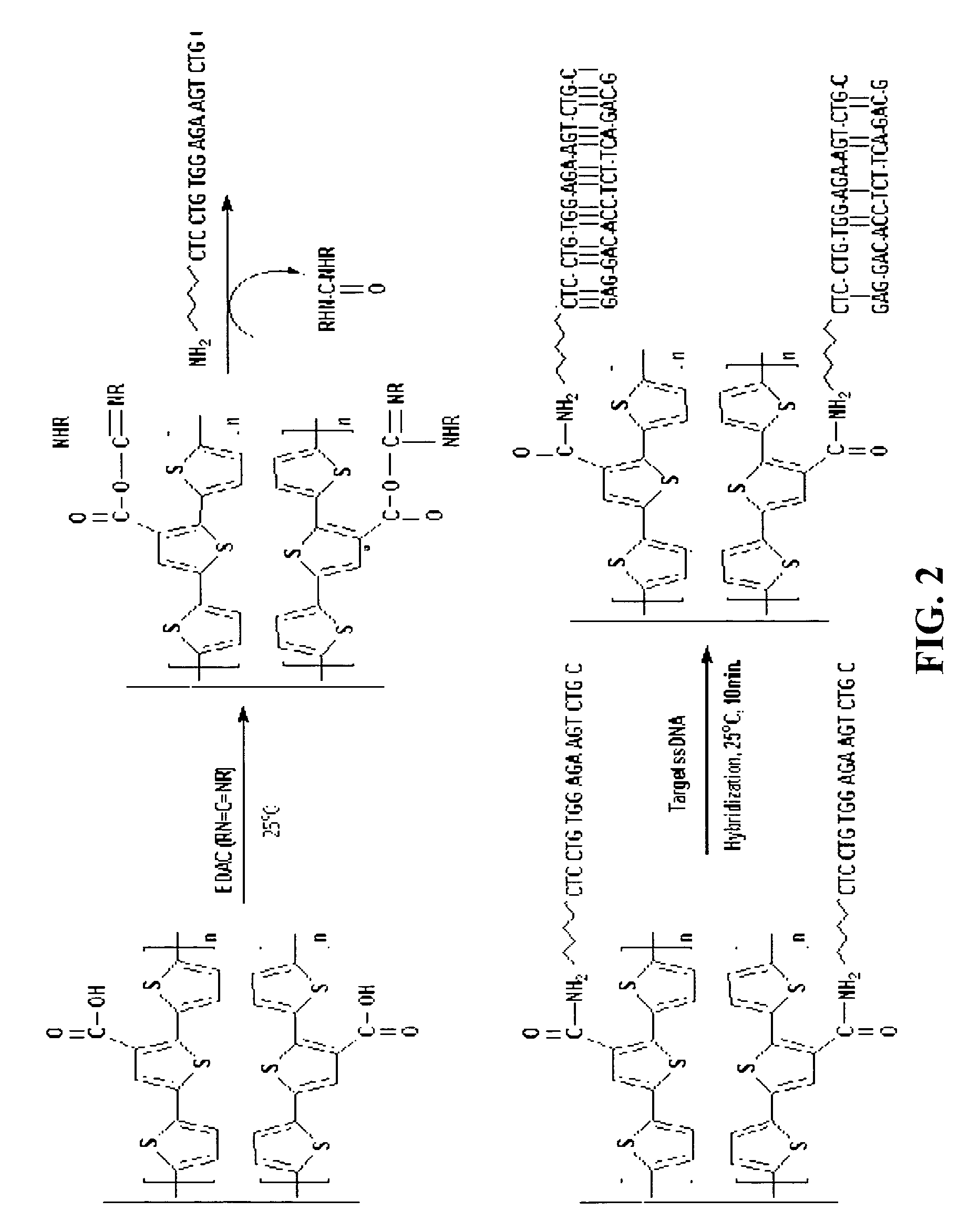Terthiophene-3-carboxylic acid compound and fabricating method thereof, functionalized conductive terthiophene polymer with the compound as a monomer, process for DNA hybridization detection using the polymer, and fabricating method of probe DNA
a technology of terthiophene and carboxylic acid, which is applied in the field of new dna hybridization detection process, can solve the problems of long time required for experimental steps, industrial disadvantage, and complicated sample preparation
- Summary
- Abstract
- Description
- Claims
- Application Information
AI Technical Summary
Benefits of technology
Problems solved by technology
Method used
Image
Examples
example 1
Preparation of 3′-carboxyl-5,2′;5′,2″-terthiophene Monomer Having Carboxyl Groups
[0043]Scheme 1
[0044]
[0045]Synthesis of 3-cyanoterthiophene: 10 mmol of 3-bromoterthiophene was refluxed in anhydrous dimethylformamide (10 ml) containing 15 mmol of copper cyanide for 4 hours. After the dark mixture was allowed to cool to room temperature it was mixed with iron chloride (10 g) in hydrochloric acid solution (20 ml, 2.0M) and maintained at 60˜70° C. for 30 minutes. The organic extract was washed with hydrochloric acid solution (20 ml, 6M), distilled water, saturated sodium bicarbonate solution and aqueous sodium chloride solution to obtain a dark yellowish solid. The obtained solid was recrystallized from an organic solvent. The product has a melting point of 83° C. and a molecular weight of 272.9736 g / mol as measured using a mass spectrometer. The structure of the product was identified through 13C NMR, 1H NMR, and IR spectrometer.
[0046]The data are as follows:
[0047]1H NMR (CDCl3): δ7.06...
example 2
Fabrication of DNA Sensor
[0051]Manufacture of a modified electrode using conductive polymer of 3′-carboxyl-5,2′;5′,2″-terthiophene having a carboxylic group: After 3′-carboxyl-5,2′;5′,2″-terthiophene monomer was dissolved in acetonitrile, the monomer was polymerized on the surface of a glassy carbon and gold electrode in accordance with an electrochemical method to produce a conductive terthiophene polymer. Subsequently, the polymer was modified [FIG. 1]. Generally, in order to electrochemically produce the conductive polymer, a voltage, at which a monomer is oxidized, is applied to a solution containing the monomer, or a cyclic voltammetry method by which a polymer is produced on the surface of the electrode, is used. In the present invention, a voltage was repetitively applied in a positive (+) direction, starting at 0.0V and finishing at +1.5V. At this time, voltage scan rate was 100 mV / sec. An oxidizing current flowed between +1.1V and +1.3V, and a reducing current flowed at +1....
example 3
Impedance Measurement
[0053]Impedance measurement was performed before and after hybridizations with target DNA sequences in a phosphate buffer. The target DNA base sequence include the completely complementary sequence B (3′-GAGGACACCTCTTCAGACG-5′), a center 1-mer mismatched sequence C (3′-GAGGACTCCTCTTCAGACG-5′), an end 2-mer mismatched sequence D (3′-CTGGACACCTCTTCAGACG-5′), and a completely non-complementary sequence E (3′-CCTAGTCTACAGGTCACTA-5′) [FIGS. 3a to 3c]. FIG. 3a shows impedances of the probe oligonucleotide (a single-stranded DNA sequence immobilized onto the conductive polymer on the electrode surface) in the frequency range from 100 kHz to 10 Hz in a phosphate buffer (pH 7.4) containing 0.75M NaCl after the probe oligonucleotide was immobilized onto the electrode surface and impedances were measured under the same conditions as above after the electrode was reacted with target DNA sequences (single-stranded DNA sequences to be reacted with the probe) for 30 minutes. F...
PUM
| Property | Measurement | Unit |
|---|---|---|
| frequency | aaaaa | aaaaa |
| pH | aaaaa | aaaaa |
| melting point | aaaaa | aaaaa |
Abstract
Description
Claims
Application Information
 Login to View More
Login to View More - R&D
- Intellectual Property
- Life Sciences
- Materials
- Tech Scout
- Unparalleled Data Quality
- Higher Quality Content
- 60% Fewer Hallucinations
Browse by: Latest US Patents, China's latest patents, Technical Efficacy Thesaurus, Application Domain, Technology Topic, Popular Technical Reports.
© 2025 PatSnap. All rights reserved.Legal|Privacy policy|Modern Slavery Act Transparency Statement|Sitemap|About US| Contact US: help@patsnap.com



